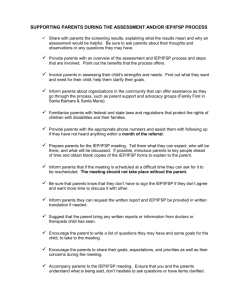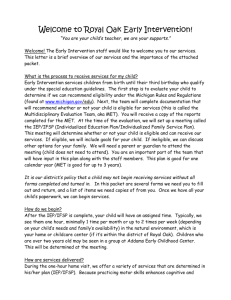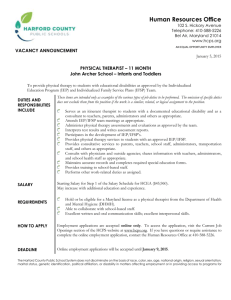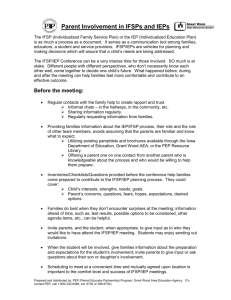Individualized Family Service Plan (IFSP) And Individualize Education Program (IEP)
advertisement
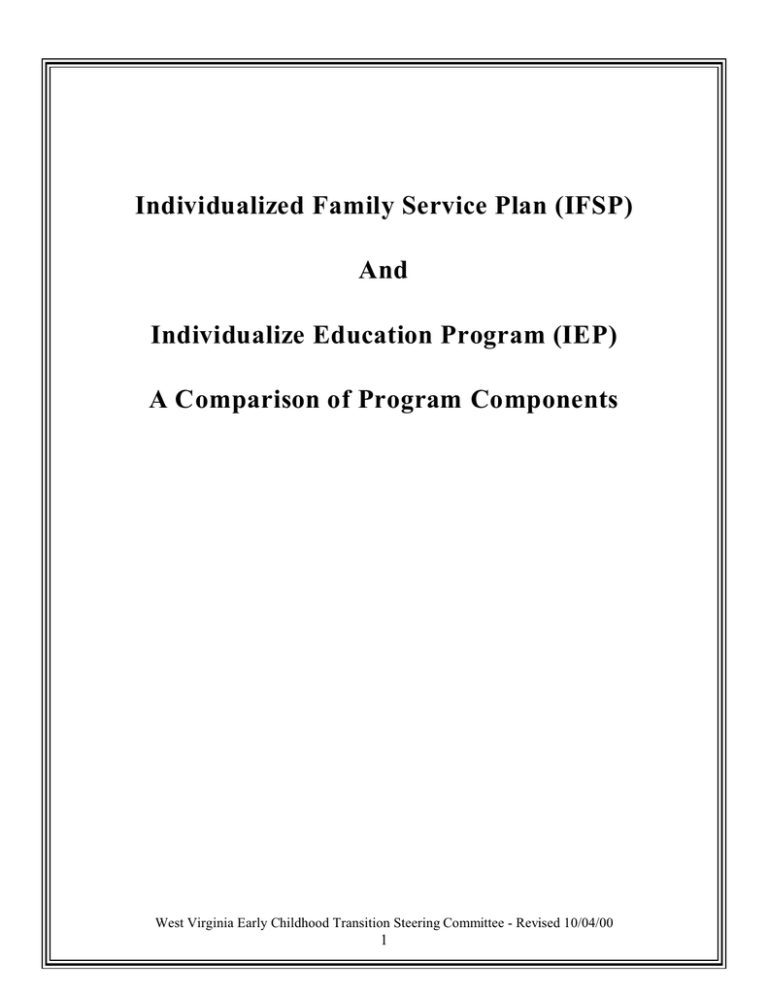
Individualized Family Service Plan (IFSP) And Individualize Education Program (IEP) A Comparison of Program Components West Virginia Early Childhood Transition Steering Committee - Revised 10/04/00 1 Comparison of the Individualized Family Service Plan and Individualized Education Program Background: The Individualized Family Service Plan (IFSP) provides the mechanism for planning and documenting the early intervention services required for an infant or toddler (birth to three) with a disability and her/his family. The Individualized Education Program (IEP) provides the mechanism for planning and documenting the special education services of school aged students with excepionalities, three through twenty-one years of age. The purpose and function of the IFSP and IEP are similar in that both provide for communication between parties, written commitment of resources, management of services and a vehicle for monitoring progress. The IFSP is also similar procedurally to the IEP in that it requires that a written plan be developed by a multidisciplinary team which includes the parents and be based on a multidisciplinary assessment of unique needs. Additionally, all early intervention services necessary to address the identified needs of the infant or toddler and the family must be reflected in the IFSP just as all special education and related services must be reflected on an IEP. Use of the IFSP by School Districts: School districts have the option to write an Individualized Family Service Plan (IFSP) instead of an Individualized Education Program (IEP) for children with disabilities ages three through five. If this option is used, parents of children with disabilities in this age group must be provided with a detailed explanation of the differences between an IFSP and IEP and must give written consent to use an IFSP in place of an IEP. If an IFSP is used, it must be developed in accordance with Part B of the Individuals with Disabilities Education Act (IDEA) and Policy 2419: Regulations for the Education of Exceptional Students. Purposes of this Document: This comparison is intended to be used as a resource and guideline for explaining the differences between these two plans and for planning and documenting services to young children with disabilities. This comparison can be used: 1) to provide parents and staff with a detailed explanation of the differences between an IFSP and IEP; 2) to help parents and professionals make an informed decision when considering services early childhood services; and 3) to promote common understanding among families, Birth to Three staff, school district staff and other relevant agencies/people involved in the transition of children from early intervention (WV Birth to Three System) to preschool special education services. Additional Questions: This document contains technical terminology regarding the provisions and process of the IFSP and IEP. If you need additional information, please contact your local special education director or the Parent Educator Resource Center (PERC) in your county. West Virginia Early Childhood Transition Steering Committee - Revised 10/04/00 2 IFSP/IEP A Comparison of Program Components Provisions of the IFSP Birth through Two Years Provisions of the IEP Three through Five Years Differences The IFSP is developed after eligibility is determined. The IFSP team, including the parents and others involved in the evaluation/assessment, must develop the written IFSP. The IFSP is based upon a multidisciplinary evaluation/assessment of the child’s development and the concerns, priorities and needs of the family related to the child’s development. The IEP is developed after eligibility is determined. The IEP Team, including the parents and a general education teacher, must develop the written document based on a comprehensive multidisciplinary evaluation. The required team participants for an IFSP and an IEP. The IFSP must include a statement of the child’s functional ability across five developmental areas. The areas are: Physical (including vision and hearing), Cognitive, Communication, Social/Emotional, and Adaptive. The IEP must include a statement of child’s present level of educational performance including how the disability affects the child’s participation in appropriate activities. IFSP requirements are more comprehensive; they specify areas in which functional ability levels must be stated. The IFSP also requires that family strengths and concerns, priorities and resources be identified with the consent of the family. West Virginia Early Childhood Transition Steering Committee - Revised 10/04/00 3 Provisions of the IFSP Birth through Two Years Provisions of the IEP Three through Five Years Differences The IFSP must include a statement of the major outcomes expected to be achieved for the infant or toddler and the family. The IEP must include a statement of annual goals, including short-term instructional objectives and benchmarks related to how the child will be involved and participate in appropriate activities, as well as how the child’s educational needs that result from the disability will be met. The goals and objectives should relate to developmentally appropriate activities and/or early childhood education curriculum. The IFSP focuses on both the child and the family within their daily routines. The IEP focuses primarily on the student’s educational hours. The IFSP must include the criteria, procedures and time lines used to determine the degree to which progress toward achieving the outcomes is being made to allow for modifications (changes) that may be needed. The IEP must include appropriate objective criteria, evaluation procedures and schedules for determining, at least annually, whether the short-term instructional objectives are being achieved. Progress must be reported to parents at least as often as progress is reported to parents of children who do not have disabilities. Essentially the same. The IFSP is reviewed on a quarterly basis because the needs of infants and toddlers change rapidly. Reviews may need to occur at other appropriate times. Meetings are held in places and at times that are convenient to families. A meeting must be at least once a year to review this IEP. Meetings to review and revise the IEP may be held more often as necessary. Meetings are held in places and at times that are convenient to families. The IFSP has more frequent required reviews. (Quarterly) than the IEP (Annually) West Virginia Early Childhood Transition Steering Committee - Revised 10/04/00 4 Provisions of the IFSP Birth through Two Years Provisions of the IEP Three through Five Years Differences The IFSP must specify the name of the service coordinator from the profession most relevant to the infant’s or toddler’s or family’s needs who will be responsible for the plan and for coordination with other agencies. Although the law permits cooperative agreements among and within agencies, there is not a specific mechanism for service coordination. Federal law requires that States set forth policies and procedures for developing interagency agreements to define respective responsibilities. The IFSP specifically requires designation of a service coordinator to ensure appropriate implementation and coordination of the plan. The IFSP should reflect coordination across the various services agencies with which the family is involved. The IFSP must include steps to be taken supporting the infant’s or toddler’s transition to preschool special education services provided through the schools or other providers. It also requires supports for the family in the transition process. Regardless of which agency provides the services, the school system is responsible for the implementation of the IEP services for a child as of the third birthday. The policies and procedures for the local school district must indicate the representative to the 90 day face-to-face transition planning meeting with the Birth to Three staff and the family. The local school district is responsible for designating a representative to attend the 90 day face-to-face planning meeting. The IFSP process requires identification of family needs in addition to child needs. The family must be informed of all of their options related to movement to the next service setting for the child. The family may have needs relating to understanding the new system or setting, the child’s particular needs, or where to get other kinds of support to provide for the optimal development of the child. The Birth to Three system (Part C) is required to begin transition planning at least 10 months prior to the child’s third birthday. They must coordinate a face to face transition planning meeting for a child exiting at age 3, at least 90 days prior to his/her third birthday, and earlier for a child who turn three during the late spring, summer or early fall. This meeting includes the family and other community representatives. The transition plan must also identify how information is to be shared among parties. West Virginia Early Childhood Transition Steering Committee - Revised 10/04/00 5 Provisions of the IFSP Birth through Two Years Provisions of the IEP Three through Five Years The IFSP must include a statement of specific early intervention services necessary to achieve the identified outcomes and objectives for child and family. Services help the child’s care givers understand and support the child’s development. Services must be delivered in the child’s natural environment to the maximum extent appropriate, and only elsewhere when early intervention cannot be achieved for the child in the natural environment. A justification of the extent, if any, to which services will not be provided in natural settings is required. Natural environment is defined as those activities and settings which are typical for the child’s same age peers who do not have disabilities. These may include home, community play groups, child care, or other community settings where children without disabilities would be typically. The IFSP may also include “other services” that are needed by the child and family. The family may receive assistance in accessing these services. The “other services” may include help with food, housing, clothing, medical care, basic education, etc. The IEP must include a statement of the specific special education and related services to be provided to the student and the extent to which the student will be able to participate in regular education programs or developmentally appropriate activities. Differences The IFSP focuses on family as well as child. The IEP is student focused. The IFSP and IEP differ regarding service delivery models; in the IFSP the least restrictive environment for infants and toddlers is considered to be home; community settings; or other natural environments. Local school districts must The least resistive environment consider the least restrictive for children in preschool may environment (LRE) for be the home, other community preschoolers. For preschool locations, child care settings or children, service delivery a school setting for IEP models for LRE may range from proposes. For school aged home or community to full day students the least restrictive center based models. environment is generally thought of as the regular education environment but is determined on a case by case basis depending on the individual student needs. West Virginia Early Childhood Transition Steering Committee - Revised 10/04/00 6 Provisions of the IFSP Birth through Two Years Provisions of the IEP Three through Five Years Differences The IFSP must include the projected dates for initiation of services and the anticipated duration of services. The IEP must include the projected dates for initiation of services and the anticipated duration of services. WV Birth to Three services may, with consent of the parents, begin before the completion of the assessment. Parent signature on the IFSP means informed written consent is given for the services listed in the IFSP. Parents have a right to agree and/or disagree with any service. Parent signature on the IEP indicates the parent participated in the development of the IEP. Informed written consent must be given by the parents for the initial provision of special education and related services as required by State and Federal law. Essentially the same. West Virginia Early Childhood Transition Steering Committee - Revised 10/04/00 7
